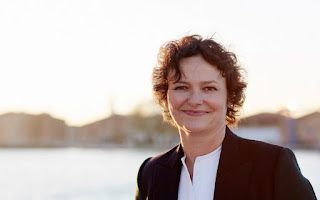(Cecilia Alemani, Curator, 9th Venice Biennale, pic source:net)
Nearly 200 artists from 58
countries. Mostly ‘women and gender non-confirming’ artists as put by the curatorial
director, Cecilia Alemani. That’s the summery of the Venice Biennale’s latest
edition slated to open on 23rd April 2022. The 59th
edition of the world’s oldest biennale was put on hold due to the global pandemic
during the last two years. The marker line that goes between the pre and post
pandemic world is not yet clear though almost all the industries have braced
themselves up to ‘live with’ the pandemic. Hopefully India’s Kochi Muziris
Biennale also would take place towards the end of this year.
Some commentators have already said
that the forthcoming edition of the Venice Biennale is based on social issues
and why should one travel all the way to Venice to catch up all those politically
correct art works when one could do some gallery hopping in any city and see
the same. Waswo X Waswo, an American-Indian contemporary artist based in
Udaipur, India opines that the ‘art world needs a cleansing and detox’. If I
have understood it correctly, Waswo says that the curatorial line of the
present edition of the Venice Biennale is too biased and politically inclined.
The question seems to be like shouldn’t we go back to the days when art was
judged for the sake of artistry and ingenuity?
Modern art, an expressive mode
adopted by feverishly intelligent individuals, has never been away from
politics. Whenever it did take an apparent detour away from the political path,
it surreptitiously upheld the larger political realities for its own existence.
The seeming neutrality was a ploy that helped many to veer towards the slippery
slopes of the investment market without leaving the claims of art for art’s
sake, while the real intention remained as investment for investment’s sake.
Art became overtly political in various countries depending on their
materialistic realities. There cannot be a linear history for this though
larger blankets could be used for making huge political packages on art.
During the last couple of Venice
Biennales, though interesting curators were involved and politics had taken an
upper hand in the formulation of the works of art, as the market boom was well
in place, gallery circuits and museum managements had made tangible and tactical
alliances, and above all the auction houses decided the tending styles and
concerns, the choices made by these curators were largely determined by the
market forces that the liberal socio-political curatorial policies never dared
to contest. The result was a set of loose packages created succumbing to the
arm twisting methods of the local market forces brokered through the locally
sourced sub curators. The works of art created for the events fell line with
the trends set by the global conglomerate of art market though in paper all
were presented as revolutionary works of art with tall claims as first of its
kind in history.
(Surrealist Leonora Carrington, Pic: Wikipedia)
Today Cecilia Alemani calls her
curatorial project, ‘The Milk of Dreams’, invoking the life and art of the
woman surrealist, Leonora Carrington. The curatorial line is unabashedly political
and one wouldn’t see a lot of fancy plumes of male vanity in those exhibition
halls in Venice. Instead, there would be many previously unheard of women
artists from the mainstream and sub-streams whose engagement with art in many
ways foreshadowed the turns that art could take in future. The post-human
contentions and claims that the project evokes or even deliberately aims at are
exclusive in terms of the avoidance of male interventions on the same but
posits women and gender non-confirming artists as the voices of all those who
have been excluded from the discursive core during the Anthropocene phase of
the globe. The code of invisibility is broken and status quo is challenged in
this exhibition, hopefully.
There cannot be an art for art sake
anymore. Art is not judged for its formal values alone. May be that is an
exclusive concern of the art makers who consider traditional knowledge of
making art and also the traditional ways of appreciating art should be left
alone to perpetuate itself in the mainstream and all else could happen in the
sidelines. Cecilia Alemani seems to turn the tables and makes things inside out
to imagine the post human world differently so that she could eventually bring
a lot of ‘humanity’ into art discourse, something that has turned inhuman in
all sense during the last couple of decades.
-JohnyML



No comments:
Post a Comment